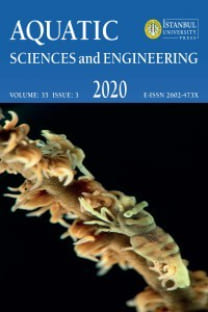ARAS REZERVUAR (İRAN)’INDA YAŞAYAN TATLISU ISTAKOZU (ASTACUS LEPTODACTYLUS)’NUN CİNSİYET ORANI, UZUNLUK VE AĞIRLIK DAĞILIMI
uzunluk ağırlık frekansı, cinsiyet oranı, kerevit, Astacus leptodactylus, Aras baraj gölü
SEX RATIO, LENGTH AND WEIGHT FREQUENCY OF FRESHWATER CRAYFISH (ASTACUS LEPTODACTYLUS) INHABITING IN ARAS DAM LAKE, IRAN
length-weight frequency, sex ratio, crayfish, Astacus leptodactylus, Aras dam lake,
___
- Abele, L.G., (1982). The Fossil Record and Biogeography of Crustacea. Academic Press, New York.
- Ackefors, H., (2000). Freshwater crayfish farming technology in the 1990s: a European and global perspective. Fish and Fisheries 1: 337-359.
- Baradaran naviri, Sh., (2001). Length and weight comparision of A.leptodactylus in Khazar lake and Aras reservoir habitats, Paghohesh and Sazandegi, 52: 94-97.
- Bayrak, M., (1985). Research on fecundity and growth of freshwater crawfish (A. leptodactylus. Esch., 1823) in Morgan Lake. Ph.D. Thesis, Ankara University, Turkey.
- Bowman, T.E. and Abele, L.G., (1982). Classification of the Recent Crustacea. Academic Press, New York.
- Cobb, J. S., and D. Wang., (1985). Fisheries biology of lobsters and crayfishes. Ch. 3. pp. 167-247. In, A. J. Provenzano (ed.), the Biology of Crustaceans. Vol 1. pp 206-208.
- Harlıoğlu M.M., (2004). The present situation of freshwater crayfish, Astacus leptodactylus (Eschscholtz, 1823) in Turkey, Aquaculture, Volume 230, Number 1, pp. 181-187(7).
- Harlıoğlu, M.M., Holdich, D.M., (2001). Meat yields in the introduced crayfish, Pacifastacus leniusculus and Astacus leptodactylus, from British waters., Aquaculture Research, 32, 411-417.
- Holdich, D.M and Lowery, R.S., (1988). An Introdaction. In Freshwater Crayfish (eds: Holdich and Lowery). Croom Helm, London. pp 1-7.
- Karimpour, M., Hossein pour, S.N., (2000). Length structure, sex ratio, and CPUE of A.leptodactylus in Aras reservoir, Iranian Journal of Fisheries Research, 9(1): 49- 64.
- Karimpour, M., Khanipour, A., Taghavi Motlagh, S., (2004). Some biological characteristics of Khazar A.leptodactylus in Anzali port beaches, Iranian Journal of Fisheries Research, 13(1): 129- 148.
- Karimpour, M., (2003). Final project report of stock monitoring of A.leptodactylus in Aras reservoir, Bony Fishes Research Center of the Caspian Sea, Anzali port, pp. 44.
- Karimpour, M., Hosseinpour, S.N., Haghighi, D., (1991). Some studies on freshwater crayfish of Anzali lagon, Iranian Fisheries Organization, pp.22.
- Köksal, G., (1988). Astacus leptodactylus in Europe. In: Freshwater crayfish: biology, management and exploitation, Holdich D.M., Lowery R.S. (Eds.), 365-400, Croom Helm, London.
- Mehraban, H., (1999). Absolute fecundity of lobster, B.S.c. Thesis, National Resources University of Zabol, p. 33.
- Mohammadi, Gh.H., Keivan, A., Vosoghi, Gh.H., Matinfar, A., (2007). The comparision of meristic characteristics of A.leptodactylus leptodactylus in Anzali lagon and Aras reservoir habitats. Pazhohesh and Sazandegi, 75: 171-180.
- Mohsenpour Azari, A., Yahyazadeh, M.Y. Mohebbi, F., Ahmadi, R.,Moniri,Y. Gangi,S., Shiri, S., (2011). Final project report of the study of environmental factors effects of Aras river and its reservoir on growth of freshwater crayfish, Iranian Fisheries Research Organization , p.172.
- Romiantsef, V., (1989). The riverin cray fishes (crabs) of Caspean Sea (in Russian), translated by Holchik, Zh., translated in Persian: Hossein pour, S.N., 1991, Gilan Fisheries Research Center, Anzali port, p.12.
- Starobogatov, Ya.I., (1995). Crustaceans. Inventory of Freshwater Invertebrates in Russia. V.2: 177-180 (in Russian).
- Vladykov, V. D., (1964). Inland Water Fisheries Resources of Iran Especially of the Caspian Sea with Special Reference to Sturgeon. 51. FAO Report, 1818. Rome.
- Westman, K., Pursiainen, M. & Westman, P., (1990). Status of crayfish stocks, fisheries, diseases and culture in Europe. Report of the FAO European Inland Fisheries Advisory Commission (EIFAC) Working Party on Crayfish. Helsinki.
- Wickins, J.F. and Lee, D.O’C., (2002). Crustacean Farming Ranching and Culture. Blackwell Science, Oxford. 446 pp. ISBN 0-632-05464-6.
- Woodland, D.J., (1967). Population study of a freshwater crayfish. Ph.D. Thesis, University of New England, Australia.
- Yayın Aralığı: Yılda 4 Sayı
- Başlangıç: 1987
- Yayıncı: İstanbul Üniversitesi
Ali AZARİ, Muzaffer HARLIOĞLU, Fereidun MOHEBBİ, Masoud SEİDGAR
ORTA VE BATI ANADOLU ENDEMİK İÇSU BALIKLARININ GÜNÜMÜZDEKİ DAĞILIMLARI VE KORUMA STATÜLERİ
Ali İLHAN, Süleyman BALIK, Süleyman BALIK, Hasan SARI, Hasan SARI
İÇSULARDA İSTİLACI BALIK TÜRLERİYLE MÜCADELEDE SEÇİCİ AVLAMA YÖNTEMLERİNİN ETKİNLİĞİ
Yakup ERDEM, Melek SAMUR, Süleyman ÖZDEMİR
Ali AZARİ, Muzaffer HARLIOĞLU, Fereidun MOHEBBİ, Masoud SEİDGAR
